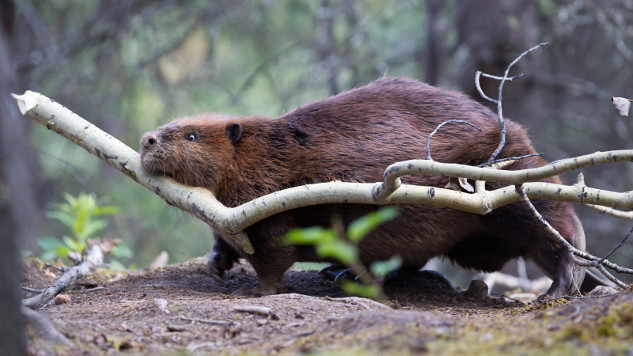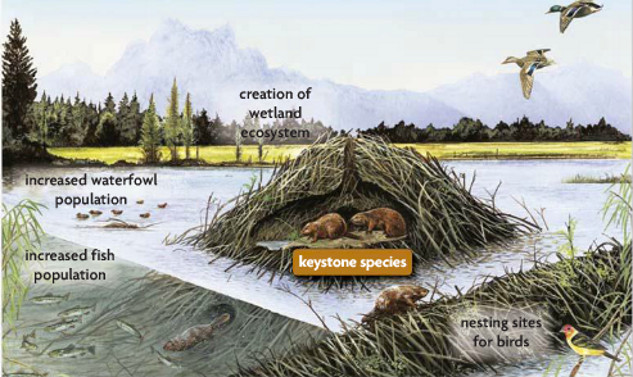
Beavers are the unsung heroes of our ecosystems. These industrious creatures, often overlooked, play a critical role in maintaining the delicate balance of nature. Through the lens of this National Geographic documentary, "Leave It To Beavers," we will gain a deeper understanding of these remarkable animals and their contributions to the world we share.
The Natural Engineers: Understanding Beaver Behavior
Beavers are well known for their unique engineering abilities, and these skills are central to their existence. With their stout bodies, webbed feet, and flat tails, beavers are superb swimmers and builders. Their dam-building activities serve multiple purposes in their lives and for the environment.
The construction of beaver dams involves felling trees, gathering branches, and packing mud to create barriers across streams. These dams create deep ponds, providing a safe habitat for beavers and other aquatic species. Additionally, these impoundments help mitigate floods by slowing down water flow during heavy rains.
Their engineering prowess extends to their lodges, constructed with underwater entrances. These lodges provide shelter and protection for beavers against predators and harsh weather conditions. Moreover, they play an integral role in the ecosystem, as abandoned clubs often serve as homes for other wildlife.
Ecosystem Impact of Beaver Dams
Beaver dams have a far-reaching impact on the environment, creating a mosaic of wetlands, crucial biodiversity hotspots. The ponds formed by beaver dams become magnets for various plant and animal species. Birds, fish, amphibians, and insects all find a home in these wetland oases.
Beaver ponds serve as essential nurseries for many fish species, offering a safe environment for their young to thrive. The shallow water and abundant vegetation provide ideal conditions for the growth and protection of juvenile fish, supporting fish populations in surrounding waters.
Beavers' dam-building activities also enhance the health of forests. By creating ponds and wetlands, beavers promote the growth of various tree species and facilitate the replenishment of groundwater reserves. The standing water in beaver ponds allows for increased soil moisture, benefiting nearby plants and fostering forest regeneration.
Keystone Species: Beavers in Biodiversity Conservation
Beavers hold the status of a "keystone species," a term used to describe organisms that have an outsized impact on their ecosystems relative to their abundance. Removing keystone species can lead to significant shifts in ecosystem dynamics and biodiversity.
Beavers, as keystone species, influence biodiversity in various ways. The habitats they create attract many species, thereby increasing overall ecosystem richness. Moreover, their foraging behavior, particularly their preference for certain tree species, can shape the composition and structure of the surrounding plant communities.
Studies have demonstrated that the presence of beavers can positively impact threatened or endangered species. For instance, in certain regions, the activities of beavers have been found to support the recovery of salmon populations by providing suitable spawning and rearing habitats.

Beavers and Climate Change Mitigation
As the world grapples with the challenges of climate change, beavers have emerged as unexpected allies in the fight against global warming. Their activities can contribute to carbon sequestration, which plays a vital role in mitigating the effects of climate change.
When beavers construct dams, the resulting ponds and wetlands trap organic matter. As this material decomposes underwater, it releases less carbon dioxide into the atmosphere than decomposition in oxygen-rich environments. As a result, beaver wetlands become carbon sinks, helping to remove carbon dioxide from the atmosphere.
Beaver ponds reduce water flow downstream, allowing sediment and nutrients to settle. This process promotes organic carbon accumulation in the soil, further contributing to carbon storage and helping combat climate change.
Beavers and Human Interaction
Throughout history, humans and beavers have shared complex relationships. Native American cultures revered beavers for their engineering skills and recognized their importance in ecosystems. However, European colonization brought changes that led to the near extermination of beavers from many areas.
As human populations have expanded, so have conflicts with beavers. Beavers' dam-building activities can sometimes cause inconveniences for human infrastructures, such as culverts and drainage systems. Flooded farmlands and roads can lead to disputes between beavers and landowners.
However, it is crucial to acknowledge that these conflicts are often a result of humans encroaching on beavers' habitats rather than the other way around. Understanding and adopting sustainable solutions for coexistence is necessary to ensure the survival of beaver populations and the ecological benefits they provide.
Beavers and Habitat Restoration
Recognizing the ecological value of beavers, conservationists and land managers have started employing these industrious creatures as "ecosystem engineers" to restore degraded habitats.
Restoration projects involving beavers focus on reintroducing them to areas where their activities can rejuvenate ecosystems. These projects mimic natural processes by allowing beavers to build dams and create wetlands, aiding in the recovery of biodiversity and ecosystem services.
Beaver-assisted habitat restoration has shown promising results in various locations, indicating that working alongside these natural engineers can yield significant ecological benefits.
Conservation and Management of Beaver Populations
Preserving beaver populations requires a concerted effort in conservation and responsible management. Understanding the current status of beaver populations, their distribution, and the factors affecting them is essential for effective conservation strategies.
Conservation efforts should focus on preserving significant, interconnected habitats to support sustainable beaver populations. Adopting legal frameworks that protect beavers and their habitats is crucial for long-term survival.
Striking a balance between human activities and the conservation of beavers is vital to ensure the continued functioning of ecosystems and the invaluable services they provide.
Ethical Considerations and Advocacy for Beavers
Ethical considerations come to the forefront as we recognize the vital role beavers play in ecosystems. Respecting the intrinsic value of these animals and their right to exist is paramount in our approach to conservation.
Advocacy groups and concerned individuals play a significant role in raising awareness about beaver conservation. Educating the public about the importance of beavers and their ecological contributions can foster a sense of responsibility for their welfare.
Encouraging community involvement in beaver conservation initiatives can lead to a more comprehensive and inclusive approach to protecting these remarkable creatures and the habitats they shape.
Leave It To Beavers Documentary
The included National Geographic documentary "Leave It To Beavers" offers a captivating and informative journey into the world of these remarkable creatures. Through stunning visuals and engaging narration, the film sheds light on the ecological importance of beavers and their impact on our environment.
By showcasing their engineering skills, habitat creation, and role as keystone species, the documentary highlights the indispensable contributions of beavers to maintaining ecological balance. Moreover, it underscores the need for human coexistence and responsible management to secure the future of these industrious animals.
About the Author
 Robert Jennings is co-publisher of InnerSelf.com with his wife Marie T Russell. He attended the University of Florida, Southern Technical Institute, and the University of Central Florida with studies in real estate, urban development, finance, architectural engineering, and elementary education. He was a member of the US Marine Corps and The US Army having commanded a field artillery battery in Germany. He worked in real estate finance, construction and development for 25 years before starting InnerSelf.com in 1996.
Robert Jennings is co-publisher of InnerSelf.com with his wife Marie T Russell. He attended the University of Florida, Southern Technical Institute, and the University of Central Florida with studies in real estate, urban development, finance, architectural engineering, and elementary education. He was a member of the US Marine Corps and The US Army having commanded a field artillery battery in Germany. He worked in real estate finance, construction and development for 25 years before starting InnerSelf.com in 1996.
InnerSelf is dedicated to sharing information that allows people to make educated and insightful choices in their personal life, for the good of the commons, and for the well-being of the planet. InnerSelf Magazine is in its 30+year of publication in either print (1984-1995) or online as InnerSelf.com. Please support our work.
Creative Commons 4.0
This article is licensed under a Creative Commons Attribution-Share Alike 4.0 License. Attribute the author Robert Jennings, InnerSelf.com. Link back to the article This article originally appeared on InnerSelf.com
Books on The Environment from Amazon's Best Sellers list
"Silent Spring"
by Rachel Carson
This classic book is a landmark in the history of environmentalism, drawing attention to the harmful effects of pesticides and their impact on the natural world. Carson's work helped to inspire the modern environmental movement and remains relevant today, as we continue to grapple with the challenges of environmental health.
Click for more info or to order
"The Uninhabitable Earth: Life After Warming"
by David Wallace-Wells
In this book, David Wallace-Wells offers a stark warning about the devastating effects of climate change and the urgent need to address this global crisis. The book draws on scientific research and real-world examples to provide a sobering look at the future we face if we fail to take action.
Click for more info or to order
"The Hidden Life of Trees: What They Feel, How They Communicate?Discoveries from A Secret World"
by Peter Wohlleben
In this book, Peter Wohlleben explores the fascinating world of trees and their role in the ecosystem. The book draws on scientific research and Wohlleben's own experiences as a forester to offer insights into the complex ways that trees interact with one another and the natural world.
Click for more info or to order
"Our House Is on Fire: Scenes of a Family and a Planet in Crisis"
by Greta Thunberg, Svante Thunberg, and Malena Ernman
In this book, climate activist Greta Thunberg and her family offer a personal account of their journey to raise awareness about the urgent need to address climate change. The book provides a powerful and moving account of the challenges we face and the need for action.
Click for more info or to order
"The Sixth Extinction: An Unnatural History"
by Elizabeth Kolbert
In this book, Elizabeth Kolbert explores the ongoing mass extinction of species caused by human activity, drawing on scientific research and real-world examples to provide a sobering look at the impact of human activity on the natural world. The book offers a compelling call to action to protect the diversity of life on Earth.



























